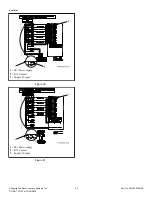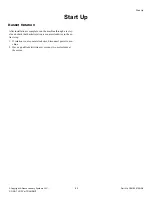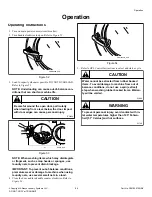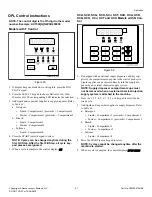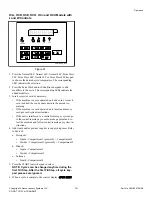
Torque, ft-lbs.
Model
Bearing
Torque
20
All
41
30-40
All
101
60
All
201
80-100
All
357
Table 47
d. Tighten door hinges and fasteners, if necessary.
7. Ensure all panels and guards are properly reinstalled.
a. Verify that the drain motor shield is in place and secure, if
so equipped.
8. Run factory test, reference programming manual for proce-
dure details and components tested.
NOTE: Refer to the Programming Manual for proce-
dure details and components tested.
9. Inspect all painted surfaces for exposed metal. Replace or re-
paint if necessary.
• If bare metal is showing, paint with primer or solvent-
based paint.
• If rust appears, remove it with sandpaper or by chemical
means. Repaint with primer or solvent-based paint.
10. Torque anchor bolts and inspect grout for cracking.
NOTE: Refer to the Installation Manual for anchor
bolt specifications.
IMPORTANT: All torque joints must remain dry (non-
lubricated).
11. Every 5 years replace inlet hoses, hose screens, belt, and fan
filter (if applicable).
Care of Stainless Steel
• Remove dirt and grease with detergent and water. Thoroughly
rinse and dry after washing.
• Avoid contact with dissimilar metals to prevent galvanic cor-
rosion when salty or acidic solutions are present.
• Do not allow salty or acidic solutions to evaporate and dry on
stainless steel. Wipe clean of any residues.
• Rub in the direction of the polish lines or “grain” of the stain-
less steel to avoid scratch marks when using abrasive clean-
ers. Use stainless steel wool or soft, non-metal bristle brushes.
Do not use ordinary steel wool or steel brushes.
• If the stainless steel appears to be rusting, the source of the
rust may be an iron or steel part not made of stainless steel,
such as a nail or screw.
• Remove discoloration or heat tint from overheating by scour-
ing with a powder or by employing special chemical solu-
tions.
• Do not leave sterilizing solutions on stainless steel equipment
for prolonged periods of time.
• When an external chemical supply is used, ensure no siphon-
ing of chemicals occurs when the machine is not in use. High-
ly concentrated chemicals can cause severe damage to stain-
less steel and other components within the machine. Damage
of this kind is not covered by the manufacturer’s warranty.
Locate the pump and tubing below the machine’s injection
point to prevent siphoning of chemicals into the machine.
Maintenance
©
Copyright, Alliance Laundry Systems LLC -
DO NOT COPY or TRANSMIT
108
Part No. F8619501ENR4
Summary of Contents for UCT020 series
Page 2: ......

